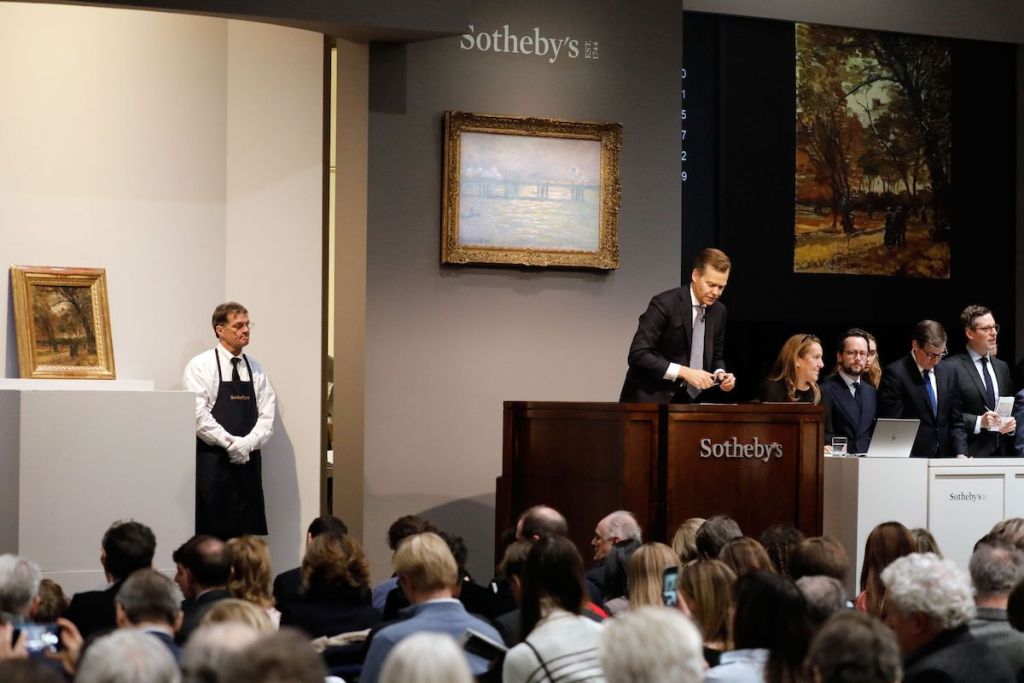[ad_1]
A new report released by the London-based art market data analysis firm Pi-eX reveals that the coronavirus lockdown has caused a decline in sales revenue and a shift toward the digital realm. Drawing from results across the top three public auction houses—Christie’s, Sotheby’s, and Phillips—the survey’s findings from the first quarter of 2020 show a 40 percent drop in total sales revenue, from $1.4 billion in the first quarter of 2019 to $800 million during the same period in 2020.
While the sweeping impact of the pandemic across global auction salesrooms has contributed to wavering market confidence among collectors and disruptions across the auction calendar, the report suggests that the decline in revenue can’t be attributed only to the shutdown in Europe and the United States—it was already taking place before mid-March.
In the U.S., the total year-on-year figures for the first quarter fell from $360 million in 2019 to $243 million in 2020, marking a total drop of 32 percent. The U.K. total also saw a 27 percent decrease, from $800 million in 2019 to $590 million in 2020.
Asia shut down earlier than the rest of the world, and this may account in part for the drop. (The marquee Hong Kong sales, which typically occur in the spring and bring in large sums, have been rescheduled to the summer.) The shutdown in Asia caused the houses to shuffle their calendars; in the case of Sotheby’s, many consignments were moved online. A decline in available property may also have contributed. In the first quarter of 2020, there were 25 percent fewer sales held at the houses than in the same period in 2019.
The top 20th-century auctions are typically a major source of revenue, but the results this year disappointed in comparison to those in 2019 and 2018. This year, the London impressionist and contemporary sales brought in $443 million—a $300 million drop from the $743 million achieved in 2019 and a major decline from the $1 billion made in 2018.
Even though houses have touted their online sales, the results for them have been significantly lower than those held in person. The Pi-eX data shows just how limited the overall impact is on total figures for online sales, noting that in the last two weeks of the first quarter of 2020, digital sales made up 46 percent of the number of scheduled auctions, and only 6 percent of the total earnings. Across the top sector of public auctions, lots estimated at or above the $1 million mark in online sales are rare. But the report does not include news of how the houses fared with private sales, which are where the highly valued works are now being traded in the run-up to major auctions slated for June and July.
The highest result for an online sale at Sotheby’s is currently $13.7 million, established by a contemporary art day sale in May. At Phillips, the highest result for an online sale came in at just $2.4 million, for a Hong Kong cross-category sale staged at the end of May, and Christie’s recent “Vice” sale, which comprised a total of 50 lots of contemporary art, brought in $2.4 million—a number far below the house’s digital record, which was set by a $9.5 million auction of Elizabeth Taylor’s jewelry in 2011. All the works in the “Vice” sale were priced at points lower than $1 million.
Pi-eX reports that online sales have historically brought in far lower results than live sales, as their offerings have lower price points. Christie’s also reported that the highest-priced lot ever sold via the auction house’s online bidding platform for a live sale was Edward Hopper’s October on Cape Cod, once in the collection of Sidney and Bernice Clyman, which sold for $9.6 million in November 2012 on an estimate of $8 million–$12 million. For a house with a long-running record of online sales, the highest price having been set eight years ago shows that the threshold for digital sales awaits a test.
Amy Cappellazzo, head of Sotheby’s Fine Art division, said that, in her 30 years in the market, this was the first time clients would be faced with an entirely remote bidding situation for the highest-value lots that come to auction. “It has never happened this way, but neither has this pandemic,” said Cappellazzo.
With auction houses venturing into new territory, they have begun to experiment—Christie’s, for example, is hosting its first-ever European art sale online this year. That house is also trying something new with its marquee “ONE” evening auction on July 10, which is being held across four locations and takes place over the course of one day. “This was about convincing and getting back feedback from the consignor,” said Alex Rotter, Christie’s head of postwar and contemporary art in New York, speaking of the risk of holding a sale as ambitious as “ONE” in this climate.
Rotter responded to questions about whether or not this was a market for high value works. He said he had to re-pitch consignors on bringing lots to the house for the summer auction, and continued, “If the market gets trickier and more difficult, which we’ve seen multiple times over the last 20 years, what is important is quality.” Rotter noted that at price points ranging between $2 million and $30 million, “if the quality is right, the buyers are here.”
[ad_2]
Source link


